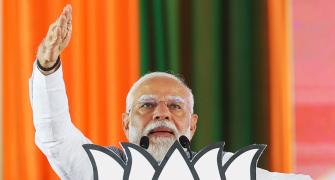Here's a short quiz. How many hip young women in India can you spot wearing a saree? Very, very few, may just be the correct answer.
"That's because, today every one is wearing practical clothing -- such as a salwar kameez or Western clothes -- and this is across all age groups," points out Mina Chawla, partner Indian Handicrafts and Ravissant.
But, Chawla is all set to change that and lure the women back to wearing the traditional saree, if only after 7 pm. She has painstakingly put together a special collection of specially woven sarees from across India with elaborate embroidery from the Awadh.
"I believe that the saree needs to be brought to the forefront. People in the West are fascinated by it and are even wearing it to the Oscars and celebrity parties. So why should Indian women let go of this marvellous heritage?" she asks.
The Awadh collection is on view at Ravissant in Delhi till September 13 after which it will travel to Mumbai and then on to Chennai.
The exhibition showcases almost 50 sarees, all inspired by chikankari embroidery, an art form and craft that flourished under the nawabs in 17th and 18th century Awadh and is around even today in modern day Lucknow.
Chawla admits she is not the first to showcase this art and acknowledges the efforts put in by designers such as Abu Jani and Ritu Kumar to revive and popularise the craft before her.
So, why did Chawla choose to focus on Awadh? She says she was always fascinated by Awadhi culture.
"It was a time when art, culture, music flourished and the most beautiful traditions such as the chikankari and zardozi embroidery emerged. I have only just touched the surface with this collection, I need to continue with my research and dig deeper," she says.
What sets Chawla's couture apart is a blend of the unorthodox with the traditional. Basic textures and weaves, high contrasts and fine craftsmanship are distinct features of her collection.
In the Awadh collection, Chawla has literally constructed sarees by combining specially woven silks in vibrant colours with delicate chikankari or shadow stitch embroidery in the base colours.
She has embellished these with either sequins or mukaish (another Lucknow embroidery done with silver metal) and antique brocade borders.
Chawla says that though chikankari was traditionally rendered on white, fine cottons or muslins she has tried to use the embroidery on other materials and textures such as thicker silk in ikat weaves from Andhra Pradesh to kanjeevarams from Tamil Nadu and tie and dye georgettes and chiffons from Rajasthan.
As a result the effect is kaleidoscopic and highly unusual from the regular fare that emerges out of Lucknow.
For the purists there are however the regular pastels with very traditional but fine work.
Motifs like paisleys, flowers, creepers, peacocks and parrots have been used with a sense of modernity on different textures.
This contemporary narration has been crafted with traditional stitches like -- murri (a knotted stitch similar to the French knot), phanda (resembling a millet) and taipchi (running or darning stitch) to fill areas.
Work on the Awadh collection began a year ago, when Chawla and her team of NID-trained designers began researching the craft. First the designs were created and then a battery of karigars at Chawla's factory translated these mini mocks of the designs on to fabric.
After various tests and finishes the mocks were sent to Lucknow where master craftsmen worked on the complete designs. So, creating one saree took almost four months to create.
Of course, all these hand embroidered and specially constructed sarees come at a price. They range anywhere between Rs 18,000 and Rs 40,000.
A bit on the steep side, but then these are designer sarees and almost like heirlooms that can be passed on to the next generation -- that is if they are still wearing sarees.






